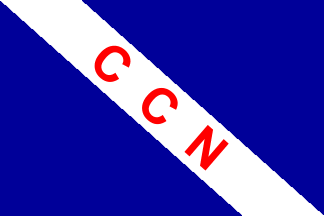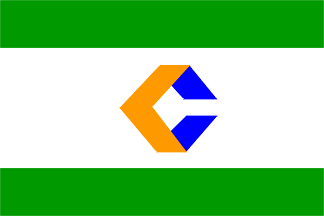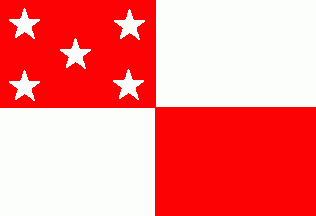 image by Joseph McMillan
image by Joseph McMillan
Last modified: 2012-01-13 by ian macdonald
Keywords: costeira | coutinho |
Links: FOTW homepage |
search |
disclaimer and copyright |
write us |
mirrors
From E. C. Talbot-Booth, Merchant Ships 1949-1950 (New York: McGraw Hill and London: Sampson Low, 1949):
Rio de Janeiro - Service to most Brazilian ports plus the United States and Europe. Managed by
Pereira Carneiro. Steamship owners since 1907, controlled by Cia
Carbonífera Rio Grandense. The flag was blue with a white diagonal
stripe, upper hoist to lower fly, inscribed in red letters CCN.
Joseph McMillan, 29 October 2002
 image by Jarig Bakker, 20 February 2006
image by Jarig Bakker, 20 February 2006
Companhia de Navegação do Norte (CONAN), Rio de Janeiro - horizontal
green-white-green flag; in center "C" consisting of one orange and two blue
parts.
Source:
Loughran (1979)
Jarig Bakker, 20 February 2006
Sources: Brown's Flags and Funnels (1951); Stewart and Styring (1963); U.S. Navy H.O. Pub 100. This company is apparently defunct. Joseph McMillan, 29 June 2001
According to E. C. Talbot-Booth, Merchant Ships 1949-1950 (New York: McGraw Hill and London: Sampson Low, 1949), Costeira was founded in 1891. Talbot-Booth shows the flag with a normal cross paty rather than the straight-edged one above. Flaggenbuch 1905 (1909 supplement) shows the cross as four isosceles triangles that don't quite meet in the middle.The Companhia Nacional de Navegação Costeira operated coastal voyages
between Rio and northern Brazilian ports (e.g., Natal, Fortaleza, Recife, Salvador). The ships were apparently quite luxurious, at
least in first class, described in one account I found as um grande playground, with voyages considered a vacation in themselves. The
line was nicknamed "Itas do Norte" from the names of the ships, all of which began with the prefix "Ita-." Supposedly the original owner
was a man named Laje, which is a Portuguese word for "stone" [actually "flagstone"] and ita means
"stone" in Tupi. Readers of Jorge Amado's novel Gabriela, cravo e canela
(Gabriela, Clove and Cinnamon) may recall that it was an Ita ship that
carried the protagonist, Mundinho Falcão, back and forth from Rio to
Ilhéus, the grounding of which provoked the dredging of the port that was
an important part of the background of the story. Costeira was nationalized at some point before 1942,
then merged in 1966 with the
government-owned Lloyd Brasileiro to form
"Companhia de Navegação Lloyd
Brasileiro e da Empresa de Reparos Nacional 'Costeira', S.A." In other words, Costeira apparently
became the ship repair arm of Lloydbras.
Lloydbras itself was abolished in 1998.
Joseph McMillan, 28 October 2002
And do Norte (meaning "northern") in the nickname Itas do Norte because the harbors served were
northern Brazilian cities. Adding to the trivia, a well-known Brazilian traditional tune goes:
Peguei um Ita do Norte(Morar and Pará do rhyme in most Portuguese-Brazilian dialects.)
e vim p'ró Rio morar:
Adeus, meu pai, minha mãe,
adeus, Belém do Pará!
Henrique Lage (not Laje, but still a pun because of the same sound) was one
serious industrial magnate--shipbuilding, salt refining, first aircraft factory in Brazil, port and river navigation development,
mining, benefactor of the military academy, close friend of President Getúlio
Vargas (dictator of Brazil beginning in 1930), you name it. And founder of the Costeira Line. His estate is now the Rio de
Janeiro Botanical Gardens, otherwise known as Parque Lage.
Joseph McMillan, 29 October 2002
The flag shows 7 white and red horizontal stripes with a blue "C" in a white
canton. The C stands almost certainly for Coutinho, a relatively common Portuguese surname.
Source: Chart of house flags
circa 1950 at
www.naufragiosdobrasil.com.br
Jorge Candeias, 4 June 2002
Listed in Lloyd's Register 1949-50 as operating three vessels totaling about 900 tons.
Joseph McMillan, 28 October 2002
 image by Klaus-Michael
Schneider, 17 April 2009
image by Klaus-Michael
Schneider, 17 April 2009
The company was located in Santos. The flag is quarterly divided into red and
white. In the red upper hoist quarter are five white 5-point stars ordered
regularly 2 above 1 above 2. It is not a Southern Cross.
Source:
Arnold
KLUDAS: Die Geschichte der deutschen Passagierschiffahrt (5 Bde.) Hamburg 1986;
Reprint Laibach Slovenia-Buch Nr. 03617-8 Flagchart p.223
Klaus-Michael
Schneider, 17 April 2009